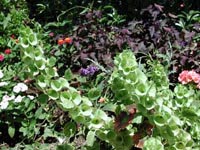Resource Library
Plant of the Week: Bells-of-Ireland
The University of Arkansas System Division of Agriculture does not promote, support or recommend plants featured in "Plant of the Week." Please consult your local Extension office for plants suitable for your region.
Plant of the Week
Bells-of-Ireland
Latin: Molucella laevis

In Ireland, March 17 is both a religious and national holiday, but for the rest of the world it’s an excuse to drink beer and die rivers green. The holiday is closely associated with shamrock - a native Irish clover - but instead I will discuss a green flower, the Bells-of-Ireland.
Bells-of-Ireland (Molucella laevis) is an annual belonging to the mint family. It can grow 3 feet tall, but the ones I have grown usually are about half that size. The plant sends up square, erect stems with clusters of leaves and flowers borne at regular intervals up the spike.
The white flowers are relatively small and inconspicuous but the green, bell-shaped calyx surrounding each bloom is large and showy. They are as wide as your thumb and crowd their way up the entire stem. The large white seeds are produced at the bottom of the calyx, looking somewhat like chicken eggs in a nest, so it’s sometimes called shell flower.
Bailey says of Molucella (also spelled Moluccella) that it's an old fashioned flower seldom offered in the seed lists. Little has changed in a century, but it can be found if you really want it.
People seem to have always been confused about where the plant originally came from. Linnaeus assigned it the name Molucella, mistakenly believing it was from the Moluccas - a chain of islands near Indonesia known as the Spice Islands. The association with Ireland seems to have occurred in the 20th century, for Bailey does not mention the name in his writings, but by mid-century all the references used the name.
In reality, Bells-of-Ireland is native to the Mediterranean region and adjacent areas of India. The association of the green calyx and the Emerald Isle was probably some crafty pitchman working for a seed company, interested in another kind of green.
Association of plants with holidays often morph into something completely unrecognizable - a kind of abstraction of the original meaning. Shamrock was the original plant association with Saint Patrick’s Day. In Ireland, St. Patrick is remembered as the 4th century religious figure who brought Christianity to the island where he used the three leaves of the wild clover to explain the Trinity.
But, clover doesn’t make an especially good houseplant, so most of the "shamrocks" I see for sale to mark the holiday are Oxalis, a completely unrelated plant from the tropics. The green calyx of Bells-of-Ireland is another of these close-is-good-enough associations.
Bells-of-Ireland are often sold as cut flowers or they can be grown in the garden. Seeds can be directly sown where they are to grow or started early and transplanted to their final location. They’re not offered in the bedding plant trade, so you will have to grow your own transplants.
In the garden, they do best in a sandy, well-drained soil in full sun. For me they have always been spotty. I’ll plant a dozen plants, and maybe only half send up the attractive flowering stem. In a good climate, they’re said to reseed, but they have not done so for me. They would be a good plant for the local cut flower growers to consider for unheated poly greenhouses.
By: Gerald Klingaman, retired
Extension Horticulturist - Ornamentals
Extension News - March 25, 2005
The University of Arkansas System Division of Agriculture does not maintain lists of retail outlets where these plants can be purchased. Please check your local nursery or other retail outlets to ask about the availability of these plants for your growing area.